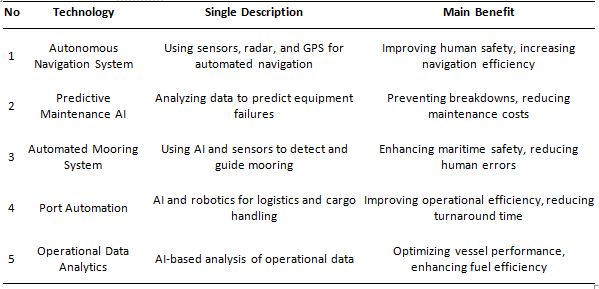Transforming the Shipping Industry with Autonomous Ships and Artificial Intelligence
Main Article Content
Abstract
The shipping industry has long been a critical component of global trade and commerce, but it has faced numerous challenges, including labor shortages, safety concerns, and the need to reduce environmental impact. In recent years, the emergence of autonomous ships and the application of artificial intelligence (AI) have the potential to transform the shipping industry, addressing these challenges and driving innovation. This study explores the role of autonomous ships and AI in revolutionizing the shipping industry. It employs a multifaceted research approach, including a comprehensive literature review, expert interviews, case studies, and quantitative analysis, to provide a detailed understanding of the key developments, potential benefits, and challenges associated with the integration of these technologies. The research findings reveal significant advancements in autonomous ship technology, with vessels equipped with advanced sensors, navigation systems, and decision-making algorithms that enable them to operate with minimal to no human intervention. The integration of AI further enhances the capabilities of autonomous ships, enabling them to process vast amounts of data, optimize routes and energy usage, and improve overall safety and reliability. The study identifies the potential benefits of autonomous ships and AI-powered shipping operations, including increased efficiency, improved safety, reduced operational costs, and decreased environmental impact. However, it also highlights the challenges that must be addressed, such as the need for regulatory adaptations, overcoming technological limitations, managing cybersecurity risks, and addressing public acceptance.
Downloads
Article Details

This work is licensed under a Creative Commons Attribution 4.0 International License.
References
M. Burmeister, K. Bruhn, O. Rødseth, and T. Porathe, "Autonomous Unmanned Merchant Vessel and its Contribution Towards the e-Navigation Implementation: The MUNIN Perspective," International Journal on Marine Navigation and Safety of Sea Transportation, vol. 8, no. 1, pp. 69-75, 2014.
A. Borshchev and A. Filippov, "From System Dynamics and Discrete Event to Practical Agent Based Modeling: Reasons, Techniques, Tools," in Proceedings of the 22nd International Conference of the System Dynamics Society, Oxford, UK, 2004.
J. Eriksen, M. Rødseth, and K. Fjørtoft, "Autonomous and Remotely Operated Ships," Autonomous Vehicles and Future Transport, pp. 111-132, 2019.
Y. Xiao, Y. Fu, and Z. Wang, "Intelligent Shipping: A Review of the Key Technologies from a Navigation Perspective," Journal of Navigation, vol. 72, no. 2, pp. 237-258, 2019.
L. Koh and S. Genovese, "Autonomous Ships: A New Frontier for the Shipping Industry," International Journal of Shipping and Transport Logistics, vol. 11, no. 3, pp. 201-218, 2019.
M. Burmeister, K. Bruhn, O. Rødseth, and T. Porathe, "Autonomous Unmanned Merchant Vessel and its Contribution Towards the e-Navigation Implementation: The MUNIN Perspective," International Journal on Marine Navigation and Safety of Sea Transportation, vol. 8, no. 1, pp. 69-75, 2014.
J. Eriksen, M. Rødseth, and K. Fjørtoft, "Autonomous and Remotely Operated Ships," Autonomous Vehicles and Future Transport, pp. 111-132, 2019.
Y. Xiao, Y. Fu, and Z. Wang, "Intelligent Shipping: A Review of the Key Technologies from a Navigation Perspective," Journal of Navigation, vol. 72, no. 2, pp. 237-258, 2019.
L. Koh and S. Genovese, "Autonomous Ships: A New Frontier for the Shipping Industry," International Journal of Shipping and Transport Logistics, vol. 11, no. 3, pp. 201-218, 2019.
A. Borshchev and A. Filippov, "From System Dynamics and Discrete Event to Practical Agent Based Modeling: Reasons, Techniques, Tools," in Proceedings of the 22nd International Conference of the System Dynamics Society, Oxford, UK, 2004.

